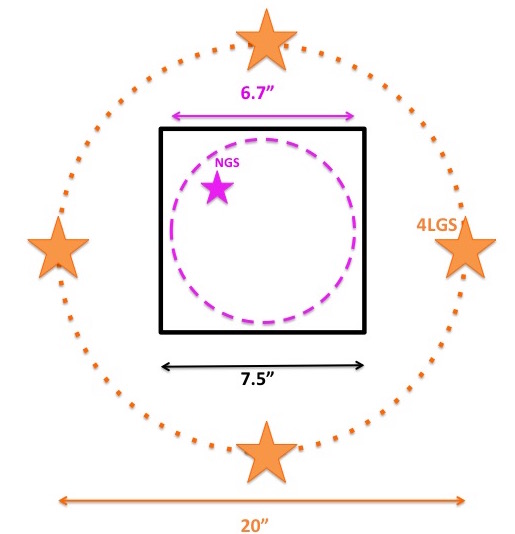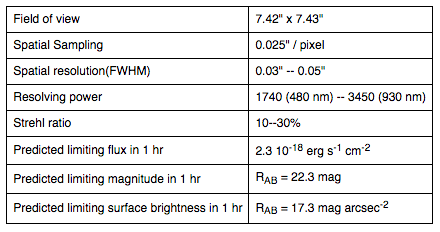MUSE Narrow Field Mode Science Verification
Contents
- General Information
- Short description of the MUSE NFM
- Approved programmes
- Phase 2 preparation
- Data access and reduction pipeline
- Useful links
- WFM-NoAO SV (2014, old)
- WFM-AO SV (2017, old)
General Information
An integral part of the commissioning of a new instrument at the VLT is the Science Verification (SV) phase. SV programmes include a set of typical scientific observations that should verify and demonstrate to the community the capabilities of the new instrument in the operational framework of the VLT Observatory. In accordance with its SV Policy and Procedures ESO encourages the community to submit also highly challenging or risky science observations that will push MUSE/AOF and the VLT to its limits in order to better understand the performance parameter space and its envelope. Such observations should focus on the instruments core modes in order to benefit a wide community.
MUSE, the Multi-Unit Spectroscopic Explorer, is an Integral Field Spectrograph located at the Nasmyth B focus of Yepun, the VLT UT4 telescope. It has a modular structure composed of 24 identical IFU modules that together sample, in Narrow Field Mode (NFM), a near-contiguous 7.5" x 7.5" field of view. Spectrally the instrument samples almost the full optical domain with a mean resolution of 3000. With the GALACSI Adaptive Optics system in combination with the VLT Adaptive Optics Facility, MUSE will offer an AO-corrected 7.5" x 7.5" field of view with 25 mas sampling.
The new adaptive-optics assisted MUSE mode is offered to the community for SV for 5 nights in August 2018. All astronomers are invited to participate in this opportunity to obtain unique science with the MUSE AO-supported NFM and thus to demonstrate its scientific capabilities. A call for proposals has been issued and the community was invited to submit proposals for the MUSE NFM science verification using the simplified proposal template. The deadline for this call for proposals is 30 May 2018, 18:00 CEST.
Proposals will be reviewed by an internal panel and allocated time on the basis of scientific merit and feasibility, as well as in the demonstrated ability of the Principle Investigators to deliver results on a timely basis.
The observations will be conducted during the nights of 7-12 August 2018 in Service Mode by a dedicated team of ESO astronomers. The MUSE NFM SV team will be able to assist the successful PI’s in the preparation and optimisation of the OB’s on a best effort basis only.
The latest version of the MUSE data reduction pipeline will be available for reduction of the SV data. Proposers are reminded that all SV data are made public worldwide immediately after passing the usual quality control checks.
Short description of the MUSE NFM
GALACSI is an AO system developed to increase the performance of MUSE. When the NFM is selected, GALACSI uses a 4 laser guide star system (LGS), the deformable secondary mirror on UT4, and an InfraRed Low Order Sensor (IRLOS) to provide a near diffraction limited resolution at visible wavelengths (i.e. SR>5% at 650 nm for 0.6” seeing). IRLOS senses and corrects the tip-tilt and focus by using a Natural Guide Star (NGS) of magnitude in the range 5 < H < 14, which must be located within a radius of 3.35" from the center of the MUSE FoV (see Fig. 1). Extended objects can be also use as NGS providing their magnitude within an aperture up to ~3" is in the range speified above. With the 4 LGS close to the optical axis (i.e. ~10" off-axis, see Fig.1), the whole turbulence volume around the telescope axis is probed, allowing to measure wavefront errors and to compute deformable secondary mirror commands through Laser Tomography AO algorithms.
Further information on the NFM can be found here.
An updated version of the MUSE ETC is now available here.
NOTE on OPERATION: If the NGS is not on-axis (i.e. NGS is not the target) then it is not possiple to apply the usual rotation between consecutive exposures, therefore in order to optimise the cosmics rejection and obtaining a uniform combined dataset in terms of noise properties exposures dithering is mandatory. In NFM the dithering pattern is performed in closed loop to minimise the overheads, therefore it is not only limited by the size of the NGS patrol field (i.e. the offsets pattern must be confined within a circle of 3.35" radius centred on the target). The offset between consecutive exposures cannot be larger than 8 pixels. Finally, mosaicking within the same OB is not possible in NFM.


Approved programmes
A total of 16 proposals have been allocated SV time. The observations were performed in Service Mode style by a dedicated team and the collected data is made available to the whole user community through the ESO Archive. See VLT SV Policy and Procedures for more details.
All (raw) data for the respective programmes will be available by following the link that will be posted in the STATUS column in the table below.
There is no proprietary period nor earlier data release to the PIs.
NOTE: Due to technical problems with one of the 4 lasers the observations were moved to September, from the 5th to the 17th.
| Programme ID |
PI Name |
Project Title | STATUS |
|---|---|---|---|
| 60.A-9480(A) | Zanella | From cosmology to star-forming regions: two compelling cases for MUSE NFM | CANCELED (Not feasible, provided NGS is too faint) |
| 60.A-9481(A) | D'Avanzo | Unveiling the properties of the environment of GW 170817 | CANCELED (Not feasible, no suitable NGS) |
| 60.A-9482(A) | Girard | Morphology and dynamics of two TTauri disks, planet formation sites | COMPLETED |
| 60.A-9483(A) | Kakkad | The interplay between inflow and outflow in a nearby merger | PARTIALLY EXECUTED |
| 60.A-9484(A) | Janson | Near-visual spectroscopy of a circumbinary planet / brown dwarf | COMPLETED |
| 60.A-9485(A) | Wertz | Revealing The Lensing Nature of Gaia GraL Gravitational Lens Candidates | PARTIALLY EXECUTED |
| 60.A-9486(A) | Alfaro-Cuello | A systematic search for an intermediate mass black hole at the core of M54 | COMPLETED |
| 60.A-9487(A) | Gadotti | The first detailed characterisation of gas inflow in double-barred galaxies | PARTIALLY EXECUTED |
| 60.A-9488(A) | Kuncarayakti | Star formation feedback, gas flows, and quenching in ULIRGs: The Bird | CANCELED (Not feasible, provided NGS is too extended and faint) |
| 60.A-9489(A) | Ferraro | Unraveling the innermost kinematics of NGC 6441 and NGC 6440 | PARTIALLY EXECUTED |
| 60.A-9490(A) | Clarke | BRIMSTONE - fire and ice on the Galilean moons | PARTIALLY EXECUTED |
| 60.A-9491(A) | Schulze | as the progenitor of the superluminous supernova PTF10tpz formed in an AGN outflow? | COMPLETED |
| 60.A-9492(A) | Usher | Does M15 contain a decoupled core? | PARTIALLY EXECUTED |
| 60.A-9493(A) | Seidel | Ultra-Compact Nuclear Rings: key to understanding AGN fuelling | COMPLETED |
| 60.A-9494(A) | Husemann | Resolving the heart of the super-Eddington Narrow-Line Seyfert 1 Mrk 1044 | NEVER STARTED |
| 60.A-9495(A) | Voggel | A SMBH merger in the making: The unique case of the nearby double nucleus in NGC7727 | NEVER STARTED |
Phase 2 preparation
The PIs (or their Phase 2 delegates) of accepted proposals must prepare and submit the Phase 2 material using P2PP3
by 20 July 2018, 12:00 Central European Time (CET)
to ensure that all observing material can be verified and is ready for the observations during the SV run between the 7th and 11th of August, 2018. Here we provide a quick checklist that will guide you through the preparation of the Phase 2 package for your upcoming MUSE-NFM SV observations.
Before you start...:
- Download and install P2PP version 3.4.3 (P2PP3)
- Check that you know your ESO User Portal username and password as you need them to log into P2PP and prepare the OBs. Please consult the User Portal FAQ for more information.
- Read carefully the short tutorial describing the requirements for the preparation of MUSE NFM OBs.
NOTE: We plan to deliver a new version of the GuideCam tool that allows to select a suitable NGS once the coordinates of the target are provided, and to create ESO compliant finding charts. USD astronomers will take care to contact all PIs of approved programmes once the tool is available.
The Phase 2 package consists of...:
- A set of OBs, constructed and submitted to the ESO database using P2PP3.
- Finding charts that are attached to OBs.
- A README file providing an overview of your programme details, also prepared and submitted from within P2PP3
Once the submission is complete..:
- Do not forget to click the Alert ESO... button (the whistle button in the tool bar) in P2PP3! This step has to be repeated for every observing run for which you are submitting Phase 2 material. Please be reminded that your phase 2 package submission, re-submission, or modification will not be processed until you have notified ESO of the completion of your submission using the Alert ESO... button.
Where to seek help...:
Please contact the ESO User Support Department in all matters regarding phase 2 preparation. Please include the programme ID in the subject line!
Data access and reduction pipeline
Interested users can access the SV frames (science only) by clicking on the programme ID listed in the table above, or simply through the ESO archive interface using the programme ID as querying filter.
Data reduction can be performed by using the following MUSE pipeline, which is an updated version of the currently available (v.2.4), and able to handle NFM mode data.
1. Install version 2.4 of the MUSE pipeline, EsoReflex, and reflex workflow using the esoreflex installation script. This is needed in order to have a running Reflex version installed.
chmod a+x install_esoreflex
./install_esoreflex
Specify, for example, the following installation path
/home/username/reflex/
The installation script will automatically create the following directory tree:
/home/username/reflex/install
/home/username/reflex/data_wkf
/home/username/reflex/download_reflex
2. Install the MUSE pipeline version 2.5.2 with the pipeline installation kit:
Make the script executable and star the installation by typing:
chmod a+x install_pipelinekit
./install_pipelinekit muse-kit-2.5.2.tar.gz
IMPORTANT: Specify the following installation directory both for the software packages and the calibration files (following the name scheme used above):
/home/username/reflex/install
3. Load the MUSE workflow by typing:
/home/username/reflex/install/bin/esoreflex muse&
and instruct the DataOrganizer to use the OCA rules available here.
To do so, double click on the DataOrganizer and provide the full path to the OCA file. Press Commit once done.
You are now ready to start using the MUSE reflex workflow with pipeline version 2.5.2. Enjoy!
Note: Please, have a look at the response curve produced by the Standard Star actor (look at the reflex_tmp_products): it might be necessary to set the --profile=circle in muse_standard. To do so,
- Open the StandarStar actor (right button click with the mouse). A pop-up window will appear, with a mini workflow in it.
- Open the Standard actor in the newly opened window and locate the RecieExecuter associated to the recipe muse_standard.
- Double clic on the RecipeExecuter, a configuration window will appear.
- Change the value of the first recipe parameter from moffat to circle.
- Press the "Commit" button and close the pop-up windows.
<path>/calib/muse-2.5.2
instead of:
<path>/calib/muse-2.4.2
